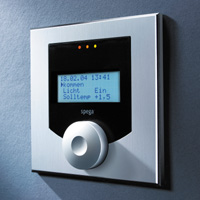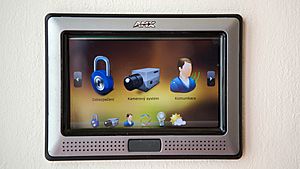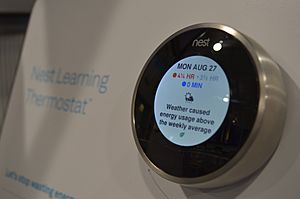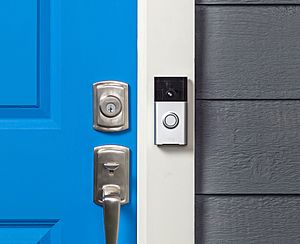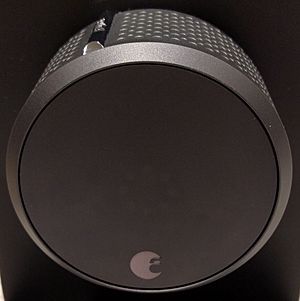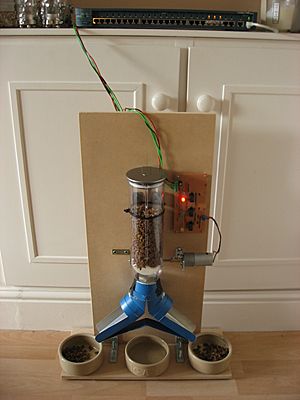Home automation facts for kids
Home automation or domotics is building automation for a home, called a smart home or smart house. A home automation system will control lighting, climate, entertainment systems, and appliances. It may also include home security such as access control and alarm systems. When connected with the Internet, home devices are an important constituent of the Internet of Things ("IoT").
A home automation system typically connects controlled devices to a central hub or "gateway". The user interface for control of the system uses either wall-mounted terminals, tablet or desktop computers, a mobile phone application, or a Web interface, that may also be accessible off-site through the Internet.
While there are many competing vendors, there are very few worldwide accepted industry standards and the smart home space is heavily fragmented. Manufacturers often prevent independent implementations by withholding documentation and by litigation.
The home automation market was worth US$5.77 billion in 2013, predicted to reach a market value of US$12.81 billion by the year 2020.
History
Early home automation began with labor-saving machines. Self-contained electric or gas powered home appliances became viable in the 1900s with the introduction of electric power distribution and led to the introduction of washing machines (1904), water heaters (1889), refrigerators, sewing machines, dishwashers, and clothes dryers.
In 1975, the first general purpose home automation network technology, X10, was developed. It is a communication protocol for electronic devices. It primarily uses electric power transmission wiring for signalling and control, where the signals involve brief radio frequency bursts of digital data, and remains the most widely available. By 1978, X10 products included a 16 channel command console, a lamp module, and an appliance module. Soon after came the wall switch module and the first X10 timer.
By 2012, in the United States, according to ABI Research, 1.5 million home automation systems were installed. As per research firm Statista more than 45 million smart home devices will be installed in U.S. homes by the end of the year 2018.
The word "domotics" (and "domotica" when used as a verb) is a contraction of the Latin word for a home (domus) and the word robotics.
Applications and technologies
- Heating, ventilation and air conditioning (HVAC): it is possible to have remote control of all home energy monitors over the internet incorporating a simple and friendly user interface.
- Lighting control system: a "smart" network that incorporates communication between various lighting system inputs and outputs, using one or more central computing devices.
- Occupancy-aware control system: it is possible to sense the occupancy of the home using smart meters and environmental sensors like CO2 sensors, which can be integrated into the building automation system to trigger automatic responses for energy efficiency and building comfort applications.
- Appliance control and integration with the smart grid and a smart meter, taking advantage, for instance, of high solar panel output in the middle of the day to run washing machines.
- Home robots and security: a household security system integrated with a home automation system can provide additional services such as remote surveillance of security cameras over the Internet, or access control and central locking of all perimeter doors and windows.
- Leak detection, smoke and CO detectors
- Indoor positioning systems (IPS).
- Home automation for the elderly and disabled.
- Pet and Baby Care, for example tracking the pets and babies' movements and controlling pet access rights.
- Air quality control. For example, Air Quality Egg is used by people at home to monitor the air quality and pollution level in the city and create a map of the pollution.
- Smart Kitchen and Connected Cooking. Using voice control devices like Amazon Alexa or Google Home to kitchen appliances.
Implementations
In a review of home automation devices, Consumer Reports found two main concerns for consumers:
- A Wi-Fi network connected to the internet can be vulnerable to hacking.
- Technology is still in its infancy, and consumers could invest in a system that becomes abandonware. In 2014, Google bought the company selling the Revolv Hub home automation system, integrated it with Nest and in 2016 shut down the servers Revolv Hub depended on, rendering the hardware useless.
In 2011, Microsoft Research found that home automation could involve high cost of ownership, inflexibility of interconnected devices, and poor manageability.
Historically, systems have been sold as complete systems where the consumer relies on one vendor for the entire system including the hardware, the communications protocol, the central hub, and the user interface. However, there are now open hardware and open source software systems which can be used instead of or with proprietary hardware.
Images for kids
See also
 In Spanish: Domótica para niños
In Spanish: Domótica para niños


